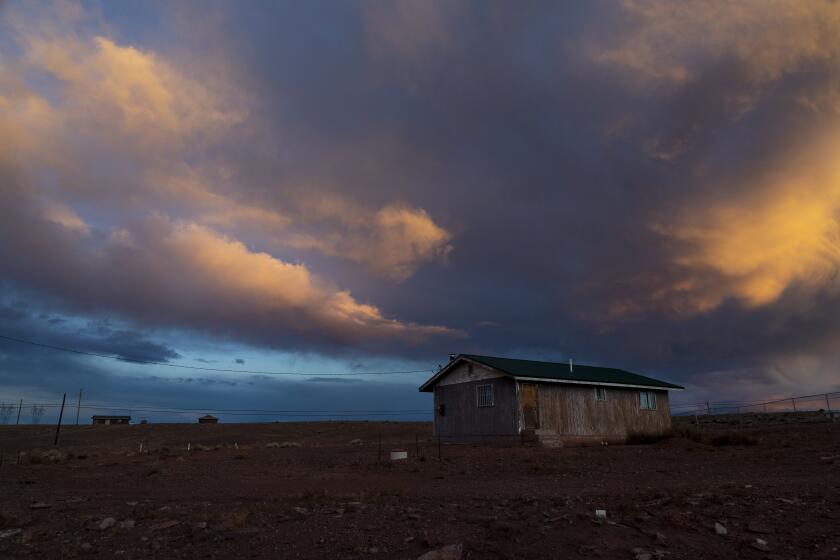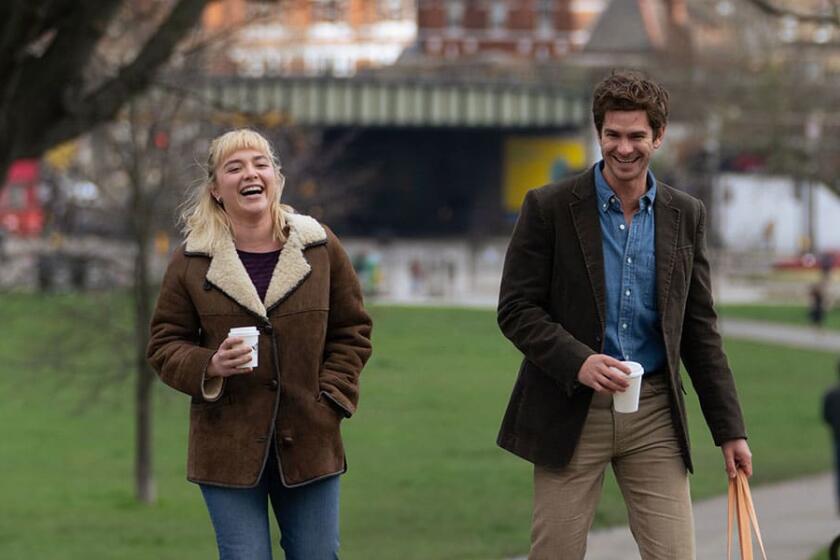How indigenous zombie horror film ‘Blood Quantum’ became prescient in the pandemic
Jeff Barnaby never thought he’d be releasing his zombie outbreak movie “Blood Quantum” during an actual global pandemic, or that the real-life parallels within a film bursting with blood, guts, a samurai-sword-wielding grandpa and severed body parts would make his groundbreaking horror tale all the more eerily resonant.
“Now that we’re in the middle of this virus it’s brought a lot of the ideas in the film into relief and stark contrast,” said Barnaby, Skyping from his home in Quebec. His second feature, now streaming on Shudder, imagines a world in which those with indigenous blood are immune to a vicious zombie apocalypse.
Set in 1981 and shot in Canada on Mohawk and Mi’gmaq land, “Blood Quantum” unfolds on the fictional Red Crow Reserve where Traylor (Michael Greyeyes), a troubled-but-trying local sheriff, struggles to lead his community as outsiders seek refuge from the rising undead.
The title puts a biting twist on the controversial U.S. government policy of measuring indigenous identity based on percentage of ancestry. But with the coronavirus now tearing across the world — heightening anxieties, escalating xenophobia, underscoring systemic inequities and disproportionately devastating the Navajo Nation — the unexpected refractions of our current reality are making Barnaby’s head spin.
“The weird thing about being native and making a comment on viruses in particular is the history of the pandemics and the colonization of America,” said Barnaby. “Once you put a native person in a zombie film, you immediately start thinking that it’s a virus. It’s one of the benefits of being a native film director: You have so much history to riff on. It exists in history and in our society and in the history of our cinema and literature.”
He paused, lingering on the thought. “It’s so much to unpack. It’s a lot to take on, being a native filmmaker, man.”
Barnaby set his 2013 debut drama, “Rhymes for Young Ghouls,” against the backdrop of Canada’s residential schools, institutions of assimilation for which the government has since apologized. Influenced by writers like Stephen King and Clive Barker, in his short films and features he’s leaned into sci-fi and horror genres, blending his pulpy directorial flair with a lens on history that’s long been absent from stories involving indigenous people.
Coronavirus anxiety is running high on Navajo Nation — a sprawling reservation of 175,000 residents, scarce supplies and resources, and only four inpatient hospitals. Cases are soaring, and at least two already have died.
Playing in fictitious alternate realities creates some distance from the presumption that he’s speaking for the indigenous community. At least, he thought it did. When “Blood Quantum” premiered at the Toronto International Film Festival, the metaphors helped its raucous horror thrills land with the weight of history. Now, it’s hard to keep current events from creeping in while watching Barnaby’s accidentally prescient tale.
“What I’ve always tried to do is infuse my work with the idea that you’re looking at fiction. At no one point are you going to be able to say these native people exist, because the world they exist in isn’t real. There’s no such thing as zombies. There’s no apocalypse,” said Barnaby. “Of course, saying that now seems kind of trite.”
At no one point are you going to be able to say these native people exist, because the world they exist in isn’t real.
— “Blood Quantum” director Jeff Barnaby
With a wicked sense of humor and sharp sociopolitical undertones, “Blood Quantum” features a cast of First Nations and Native American actors led by Greyeyes (“True Detective,” “Fear the Walking Dead”), Elle-Máijá Tailfeathers (“The Body Remembers When The World Broke Open”), Forrest Goodluck (“The Revenant,” “The Miseducation of Cameron Post”) and Kiowa Gordon (“The Twilight Saga,” “Roswell, New Mexico”).
Ravenous hordes descend, chainsaws swing, heads are liberated from their reanimated corpses and Barnaby winks gleefully more than once at Quentin Tarantino’s “Pulp Fiction.” In one scene, Waylon Jennings roars on the 8-track as a hero goes head-to-head with flesh-eating zombies; in another, a character receives a painful surprise during oral sex when his infected partner turns at an inopportune moment (a commentary on post-colonial misogyny and toxic masculinity, the filmmaker says amusedly).
As the apocalypse unfolds, old wounds fester and conflicting views on self-preservation put the group’s survival into jeopardy. Half-brothers Lysol (Gordon) and Joseph (Goodluck) bond over their strained relationships with their dad, Traylor; Joseph, who has a baby on the way with his white girlfriend, Charlie (Olivia Scriven), wrestles with fearful unknowns; his mother Joss (Tailfeather), Traylor’s ex and a trained nurse, quietly springs into action when the reservation seals itself from the outside world, then comes under siege.
Veteran actor Greyeyes, whose stage and screen career has often explored indigenous experiences but rarely with an indigenous filmmaker at the helm, loved the premise from the start.
“It’s not just a film, it’s a political action to flip the switch and go, ‘The land that we deemed worthless, the rez that we stuck you on? That is now the safest place in the world. Whereas we pushed you away from the heart of our communities, now we’re seeking entrance into yours,’” he said. “This idea that colonial history has been reenacted subversively is a message that even the most non-political, non-socially informed person will understand right away.”
“Blood Quantum” blends the zombie movie DNA of George A. Romero’s “Night of the Living Dead” with the sociopolitical lineage of the 1984 Alanis Obomsawin documentary “Incident at Restigouche,” which chronicled raids by Quebec police upon the Listuguj Mi’gmaq First Nation over salmon fishing rights in 1981, the year “Blood Quantum” takes place.
In an opening nod to Obomsawin’s film and the community’s history, a gutted pile of fish are the first to rise from the dead. Traylor’s WWII vet father Gisigu (Stonehorse Lone Goeman, a sword-wielding standout making his acting debut) eyes his haul with disbelief as they flop back to life, then steely resignation sets in. Zombies? Fine. He’s seen and survived plenty before, the movie suggests. What’s an undead outbreak to someone who’s made it through so much already?
Barnaby grew up in Listuguj at the time of the raids and always envisioned his hometown as the setting of “Blood Quantum.” Before making the film in Listuguj and on the Kahnawake reserve near Montreal, he asked his actors to watch “Restigouche” so they’d understand the community’s history and its hard-won traditions. For many of the cast members, “Blood Quantum” marks a leap forward in screen representation.
Devery Jacobs made her starring debut as the teen heroine of Barnaby’s “Rhymes for Young Ghouls,” also set in the fictional Red Crow community and filmed on the Kahnawake reserve where she grew up. In “Blood Quantum” she plays James, a hardened version of the woman her headstrong “Rhymes” character might have become “if she had turned to the dark side.”
“I wouldn’t have a career today if it wasn’t for Jeff and for that project,” said Jacobs, whose recent credits include Netflix series “The Order” and Starz’s “American Gods.” “’Rhymes’ was my first leading role and also the first role I could really sink my teeth into, and the first project that really reflected my experience and that of my family’s.”
Tailfeathers had just wrapped the final scene of her award-winning film “The Body Remembers When the World Broke Open,” about two indigenous women who spend a fateful day together, when she caught a cross-country redeye from Vancouver to shoot “Blood Quantum” in 2018. Her character, Joss, “is so many indigenous women that I know,” said Tailfeathers.
“It’s indigenous women who hold up our communities,” she said. “She’s a nurse, she’s a single mom, she’s a survivor — she does so much for her community, and much of that work goes on quietly, behind the scenes. I think that’s very true for a lot of communities, where it’s the women who are putting in a lot of the work to hold us together and to keep our cultures and language strong.”
Tailfeathers’ mother is a physician on the Blood reserve in Alberta, which, given the timing, has brought systemic traumas even further into view amid the pandemic. “I certainly hope that it stirs up necessary dialogue and people understand that there’s a lot going on for indigenous people right now,” she said. “I hope that people become more politically engaged and walk away with some of the important messaging that exists in the film.”
It wasn’t easy getting “Blood Quantum,” a rare film to feature the Mi’gmaq language and characters, to the screen. Working with his “Rhymes” cinematographer Michel St-Martin, Barnaby served as writer, director, editor and composer. There were tough days filming on location in the elements; limited resources; over-the-top stunts.
On top of the typical indie film constraints, Goodluck felt the added pressure of having to film a heavy emotional moment during a zombie outbreak while standing in a small boat against a thicket of fog with a team of FX pros circling, faux blood at the ready. “They were trying to create this crazy Kurosawa-type atmosphere,” said Goodluck. “It was scary because I was like, if I don’t get this during this take, I know we’re not going to get another one!”
Production even went on hiatus for several months while the weather changed and Barnaby banged on doors to secure funds to finish the film. But at least he found receptive backers. When he’d first pitched the project in 2007, he said, no one would bite.
“It was a different time. Nobody was ready for a story like this,” he said. “Nobody was ready to hear that the great capitalist dream was falling apart and colonialism was going to help usher us into destruction. So it was the culture that took catching up to the script. Nothing changed, just the cultural perception of it.”
Nobody was ready for a story like this... It was the culture that took catching up to the script.
— Jeff Barnaby on “Blood Quantum”s decade-plus journey
The timing feels apt to Goodluck and Gordon, whose characters represent challenges facing youth stepping into a world not of their making. “It’s especially relevant today with every aspect of global destruction that young people are inheriting, from not just the native communities but everywhere older generations have messed up the planet, possibly to the point of non-reversal,” said Goodluck.
His character manages to hold on to hope. Gordon’s Lysol, on the other hand, bears the scars of his fractured upbringing. “He doesn’t know how to reconcile,” said Gordon. “The only way he knows how is through violence, what he grew up with.”
Gordon, who is of Hualapai descent and was raised partly on his tribe’s reservation in Arizona, found that the film’s themes, and its provocative title, resonated with elements of his own ongoing journey.
“It’s been a struggle my entire life, being who I am and trying to find out who I am,” he said. “I’m on the cusp of even being in my tribe because of the blood quantum. My daughter isn’t registered into my tribe because of that, because she only has a particular quantum in her. How does somebody else get to define who we are? It messes you up in the head.”
“In this industry, ever since natives were in cinema, it’s always been somebody else’s voice, and somebody else’s face, and somebody else’s makeup on them. Now we can actually take that back, and this film is iconic for that,” he said. “[‘Blood Quantum’] is ushering in a new age for the next generation to say, ‘OK, let’s go out there and take our lives back.’ I feel empowered through this.”
Barnaby aims to open the door to larger conversations through his films. He was already writing his next project, a “cosmic horror” script probing native storytelling tropes, when the COVID-19 pandemic hit. Now he’s rewriting it for the age of coronavirus. “I don’t see how any artist leaves this out of their stories from this point on,” he said. “You’re going to see all sorts of crazy stuff happening because of what people had to do to survive this virus.”
After all, artists make art to help process traumatic events, Barnaby said. “I think that’s my role in society. People in Canada are trying to reconcile their history, and I think my movies help do that because they put it in an entertaining light where you can discuss the film and eventually move onto more serious topics.”
He laughed with a hint of irony, landing on an analogy for how he hopes “Blood Quantum” finds its way in the world. “My films are a gateway drug to better conversations.”
'Blood Quantum'
Not rated
Running time: 1 hour, 36 minutes
Playing: Available on Shudder
More to Read
Only good movies
Get the Indie Focus newsletter, Mark Olsen's weekly guide to the world of cinema.
You may occasionally receive promotional content from the Los Angeles Times.












